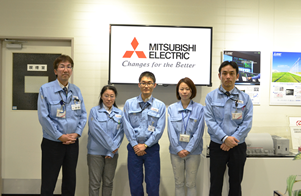Mitsubishi Electric Corporation
CACHATTO as an alternative to complicated VPN connections
Management Information Systems Section staff:
Mr. Keita Hiro
- Senior Manager
Mr. Naoki Kanto
- Manager
Ms. Yuri Takada
Mr. Masaaki Oka
Ms. Keiko Takimoto

Mitsubishi Electric was established in 1923 in Kobe by Mitsubishi Shipbuildingʼs Mitsubishi Production Industry which produced seafaring vessels, industrial electric motors, and generators. Since then, it has expanded to support Japanʼs electrical energy infrastructure. Kobe Manufacturing, taking its name from the home of Mitsubishi Electric Corporation, is involved in a large range of industries including water & sewage systems and railway/highway systems, as well as disaster prevention, large-scale building management, and electrical energy information.
Meanwhile, Energy Systems Center, which operates in Kobe with Kobe Manufacturing, develops and manufactures systems related to generators and power plants.
Both companies began searching for a remote-access infrastructure for company-loaned smart devices, and decided on CACHATTO in September 2014.

Senior Manager Mr. Hiro explained about the Management Information Systems Section of the Engineering, Manufacturing and Information Systems Department. The Information Systems Department at Mitsubishi Electric Corporation Kobe Manufacturing/Energy Systems Center supports the system infrastructure for the companyʼs design, development, and management for roughly 5,500 users.
'Remote access service was one part of the Workstyle Transformation project. We wanted to utilise smart devices to improve work efficiency. In order to implement BYOD practices, we needed a tool that put priority on security. We were hoping that by allowing our employees to use their personal devices, they could make better use of their idle time, including travel time.'
Ms. Takada, who led CACHATTO implementation project from the start of the product selection, provided details on the project. 'We started using iPads in 2012 and iPhones in 2014 for remote-access use, such as with the sales group employees to borrow when working outside the plant.' 'We chose iOS devices after comparing them with the latest Android devices for security requirements and ease of management.'
'Previously we had been using a VPN for smart device remote-access, but the process of connecting with the VPN was complicated, and could not be used for quick access, such as checking email during transit or in oneʼs spare time.
'Thus, in November 2013, to make the remote-access process easier, we started looking into new systems for smart devices and cellphones. Being able to view Exchange emails, schedules, address books, and the file server was a crucial factor during the selection process.'
During the remote-access selection process, NEC*1 suggested CACHATTO to Kobe Manufacturing/Energy Systems Center, and in June 2014 they set up a trial version of CACHATTO on their corporate server to test for compatibility with the Exchange server, operability, etc. The first impression given by the trial team members was that CACHATTO was easy to use. Further tests for security features were done in tandem.
Along with operability being well received, CACHATTO was deemed favorable for its security features. After installing CACHATTO SecureBrowser (hereafter referred to as 'SecureBrowser') on the device, CACHATTO prevents data from being stored on the device, and uses 2-factor authentication with the individual device ID. Furthermore, there is a confirmation notification before an email is sent, preventing emails from being mistakenly sent.*2 All of the security features were reviewed favorably, and CACHATTO was officially implemented in September 2014.
The official implementation of the CACHATTO system was reportedly very smooth; all that was needed was to import data from the trial version of CACHATTO to the official version and make a few minor changes.
To find employees interested in using the new system, designated 'office automation representatives' from each group were requested to attend an information session that explained the goals, operation, etc. of the new remote-access system. The representatives were tasked with communicating the information to their respective groups.
At the company, devices that were for loaning out had to have the application installed and settings prepared by the Information System Group, and could only be released to approved users. Likewise, for CACHATTO the SecureBrowser was pre-installed and the user ID and access point was set by the Information System Group before the user could borrow the device.
As a result, users could access CACHATTO as soon as they received the device. The user manual was available on an intranet site, but it was hardly ever needed, and there were very few queries from employees regarding usage.
Mr. Kanto said, 'There were so few queries that at first we thought CACHATTO wasnʼt being used, but we were reassured after checking the access logs and seeing that people were indeed using it. Looking at the times of access, administrative workers mainly used it during their morning commute or after returning home.
Originally the iPad was the most frequently distributed device, but for CACHATTO, the iPad and iPhone seemed to be used in equally, and a decent percentage of people seemed to be using it on their feature phones too.'
Ms. Takada said, 'We received favourable comments from users regarding easy access with CACHATTO, without the complicated steps required previously.'
On the other hand, users concerned about security asked 'CACHATTO connects to the corporate web with an internet connection (as opposed to the previous VPN system(, but is that really safe?'. Their fears were laid to rest after hearing that CACHATTO communicates only via an outbound HTTPS connection; its communications are encrypted, and leaves no data on the device.
Finally, the company provided their thoughts on further developments regarding CACHATTO and made their requests for features. Ms. Takada said, 'CACHATTO continues to be a crucial part of the infrastructure for smartphones and cellphones in the company. We hope to further expand its use.'
As for requests for CACHATTO features, Mr. Kanto said, 'It would be nice if there was an icon on the TOP menu that provided end users with updates and news about CACHATTO.'
Mr. Hiro added, 'It would be beneficial and would reduce errors if there was a user interface for left-handed people. Also, in the future, we would like to able to use CACHATTO in conjunction with an instant messenger feature for the workplace, so that it can be used safely outside the office without having to make changes to the firewall. That way, CACHATTO can also function as a communication tool, which would significantly increase the number of users.'
Based on their responses, Kobe Manufacturing/Energy Systems Center seem very familiar with CACHATTOʼs features, and are continuously aware of what improvements are needed for the Information System Group to function well and manage their numerous systems.
*2 For information on the notification popup feature, please inquire to the CACHATTO Support Center.
*3 OWA: Outlook Web App, web mailer client for Exchange or Office 365

